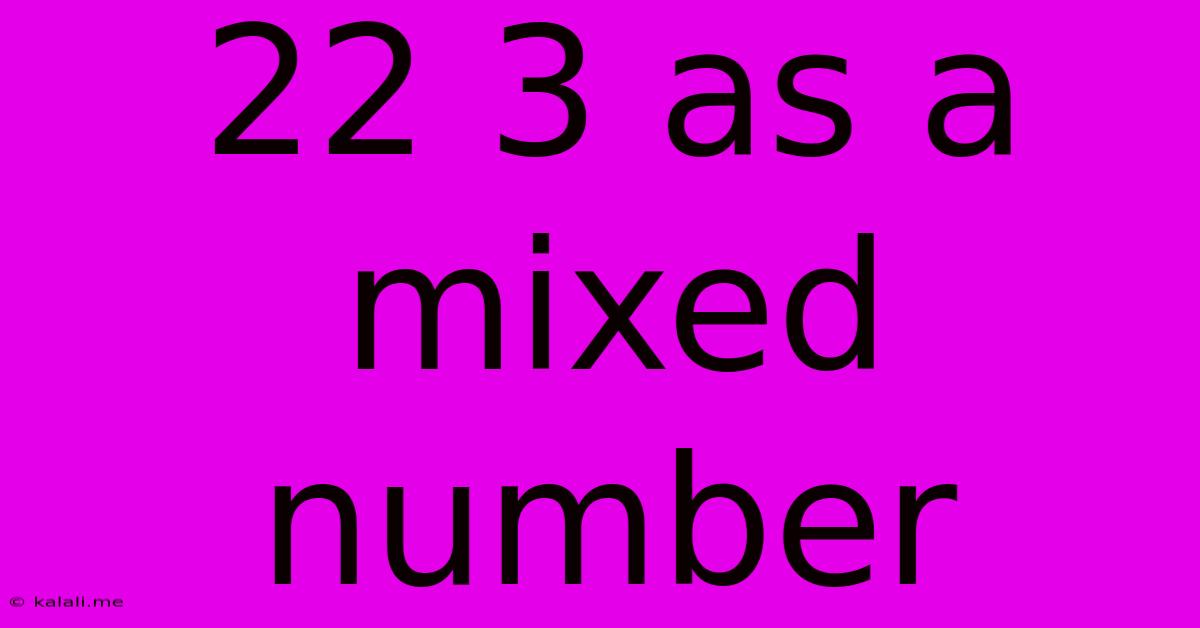22 3 As A Mixed Number
Kalali
May 09, 2025 · 2 min read

Table of Contents
22/3 as a Mixed Number: A Comprehensive Guide
Converting improper fractions, like 22/3, into mixed numbers is a fundamental skill in arithmetic. This guide will walk you through the process, explain the underlying concept, and provide you with practical examples to solidify your understanding. Understanding this conversion is crucial for various mathematical operations and problem-solving scenarios.
What is a Mixed Number?
A mixed number combines a whole number and a proper fraction. A proper fraction is one where the numerator (top number) is smaller than the denominator (bottom number). For example, 1 ¾ is a mixed number: 1 is the whole number, and ¾ is the proper fraction.
Converting 22/3 to a Mixed Number
The key to converting an improper fraction (where the numerator is larger than the denominator) to a mixed number is to determine how many times the denominator goes into the numerator and what the remainder is. Let's break down 22/3:
-
Division: Divide the numerator (22) by the denominator (3). 22 ÷ 3 = 7 with a remainder of 1.
-
Whole Number: The quotient (7) becomes the whole number part of your mixed number.
-
Proper Fraction: The remainder (1) becomes the numerator of the proper fraction, and the denominator remains the same (3).
-
Result: Therefore, 22/3 as a mixed number is 7 ⅓.
Why is this Conversion Important?
Converting improper fractions to mixed numbers often makes it easier to:
- Visualize quantities: It's simpler to understand 7 ⅓ pizzas than 22/3 pizzas.
- Perform calculations: Adding and subtracting fractions is sometimes easier with mixed numbers, especially when dealing with whole numbers.
- Solve real-world problems: Many real-world applications, such as measuring ingredients in recipes or calculating distances, use mixed numbers for clarity.
Further Examples:
Let's practice with a few more examples:
-
17/5: 17 ÷ 5 = 3 with a remainder of 2. Therefore, 17/5 = 3²/₅
-
25/4: 25 ÷ 4 = 6 with a remainder of 1. Therefore, 25/4 = 6¼
-
10/3: 10 ÷ 3 = 3 with a remainder of 1. Therefore, 10/3 = 3⅓
Converting Mixed Numbers back to Improper Fractions
It's also useful to know how to reverse this process. To convert a mixed number back to an improper fraction:
- Multiply: Multiply the whole number by the denominator.
- Add: Add the result to the numerator.
- Keep the denominator: The denominator remains the same.
For example, converting 7 ⅓ back to an improper fraction:
- 7 x 3 = 21
- 21 + 1 = 22
- The denominator remains 3.
Therefore, 7 ⅓ = 22/3.
This comprehensive guide should equip you with the knowledge and skills to confidently convert improper fractions like 22/3 into mixed numbers and vice-versa. Remember to practice regularly to master this essential mathematical concept. Understanding this conversion will improve your problem-solving abilities and mathematical fluency.
Latest Posts
Latest Posts
-
60 Inches To Feet And Inches
May 09, 2025
-
How Many Kilograms Is 5000 Grams
May 09, 2025
-
18 Is What Percent Of 75
May 09, 2025
-
What Number Is Equivalent To 1 3
May 09, 2025
-
Cuanto Es 34 Fahrenheit En Centigrados
May 09, 2025
Related Post
Thank you for visiting our website which covers about 22 3 As A Mixed Number . We hope the information provided has been useful to you. Feel free to contact us if you have any questions or need further assistance. See you next time and don't miss to bookmark.